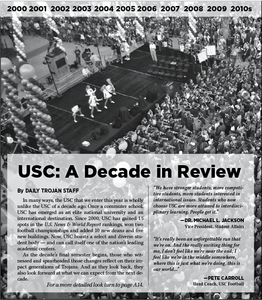Study: USC driving force in Los Angeles economy

Champions · From January 2005 — Trojan fans celebrate the football team’s 2004 National Championship victory in front of Tommy Trojan. The victory was the second consecutive national title for USC football. | Photo courtesy of Joel Zink
Despite the recent economic decline, an independent study has found that USC’s economic impact on the Los Angeles area has risen nearly $1 billion in three years.
A study conducted by Economic Research Associates found that USC — the city’s largest private sector employer — has an economic impact of $4.9 billion per year on the region, compared with a $4 billion economic impact in 2006.
Economic impact measures the effect on employment, income and spending generated by a decision or policy. The study of USC’s economic impact measured the effect on spending and employment in the surrounding area relative to USC’s projects, spending and policies.
The study accounted for USC’s operational expenditures, but did not include the direct spending or impact of USC’s affiliated hospitals. According to the study, for every dollar USC spent in Los Angeles County, an output of 63 cents was generated somewhere else in the regional economy.
Councilman Bernard Parks, whose district includes USC, attributed the increase in economic impact to the construction happening all around campus. He added, however, that USC has always been a positive force in the Los Angeles economy.
“The hiring of students and the hiring of locals, those have been a staple for a long time in the Los Angeles region,” Parks said. “There’s a very positive impact USC makes anywhere from the adoption of local schools, the maintenance of their campus and the area around it and the benefits of having some 40,000 students in the local area supporting businesses.”
During the 2008 fiscal year, the study found USC spent $130 million on capital projects. Other expenditures included $21 billion in total direct spending, $1 billion in wage and payroll expenditures and $430 million in purchasing expenditures.
Students and visitors also contributed to the university’s economic impact, as students spent $503 million for goods and services and visitors spent about $12 million.
James Grant, director of USC Media Relations, said the university has always had a large economic impact.
“USC has been a major part of the community since, well, more than 125 years,” Grant said. “The bottom line is that USC and its economic impact is a bright spot in what is a very uncertain economy right now … Despite economic issues, USC continues to help fuel this local and regional and national economy.”
Parks said the economic and cultural contributions that USC makes as a corporate citizen of Los Angeles have a very positive impact on the surrounding area.
“[A corporate citizen is] somebody that understands their mission as it relates to their particular job, but is always looking to incorporate the local community in the configuration of their decision-making,” Parks said. “The USC community is not just an inclusive group that grinds out students, gets tuition and goes home … they’re also giving as much as they’re getting from the community.”
Aaron Yee, a senior majoring in public policy, management and planning, said the economic impact USC has on its surrounding area is probably the most significant effect USC has on its community.
“It’s definitely the economic generation that the university brings to the city, since suburbanization and sprawl have taken so much industry and financial resources away from the city core,” Yee said. “I think USC and its needs are serving as a catalyst for revitalization of this area.”
